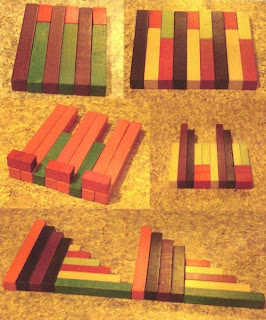As a variation on this theme, we made a game of placing a bunch of rods of all sizes in an opaque cloth bag. The first version of our game required the player to grab a rod (unseen) and predict the color before she removed it from the bag. When this became too 'easy', the mission became finding a specific color rod in the bag and pulling it out. Another variation had the player building a staircase and then a reverse staircase-- in other words, rods of ten different sizes had to be pulled out of the bag in order from smallest to largest then from largest to smallest. This is easier if there are only ten rods in the bag (ok as a beginning version) but harder when there are three or four or five of each color in the bag.
These sort of tactile games are more important for some children than for others, but I have found them useful all around. Children with learning disabilities or deprivations of various sorts seem to especially benefit from the exercise. I once worked with children so culturally deprived they couldn't, at ages five and seven, recognize themselves in a photograph or understand two dimensional representations so as to make sense of a story book. They were enormously helped by a French game called Tactilo which I can't seem to find anywhere now. It was by Fernand Nathan and consisted of beautiful little wooden shapes-- cube, sphere, egg, cone, mallet, bowl, mushroom,etc and cards with matching two dimensional pictures. The object was to reach into a little silk bag and pull out objects to match the flat pictures. It's easy to take skills for granted that little ones need to learn in one way or another in order to move forward in math. And it's also why it's important to allow for plenty of block play, math games, spatial relationship and pattern learning to take place before "jumping the gun" into formal numerical instruction.
When I was, recently, discussing the 'bag' game for Cuisenaire rods with my daughter, she made the suggestion that the game could be adapted to Pattern Blocks as well for the purpose of learning the shapes by feel. Sounds like a great idea to me.





















































